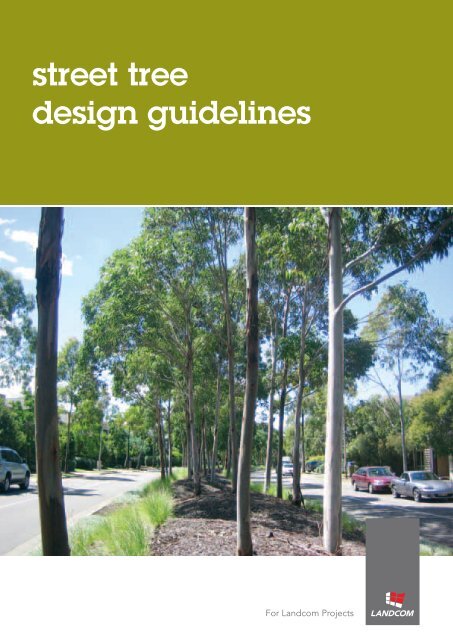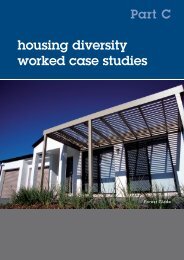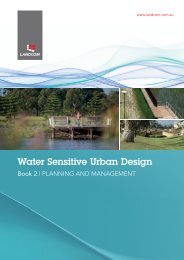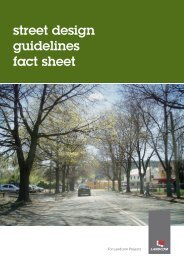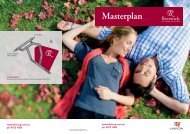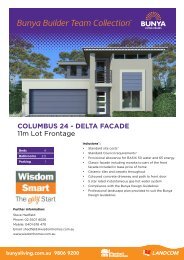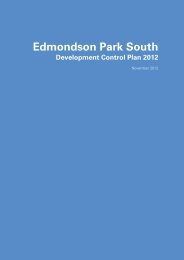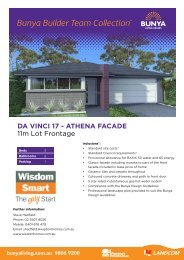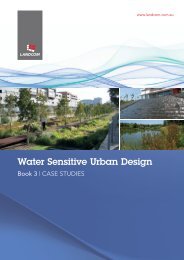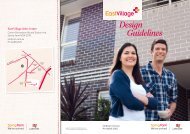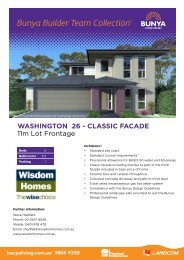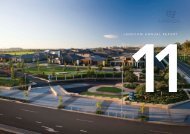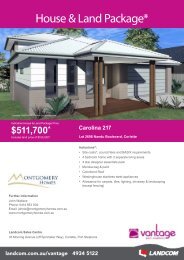Street Tree Design Guidelines V7.indd - Landcom
Street Tree Design Guidelines V7.indd - Landcom
Street Tree Design Guidelines V7.indd - Landcom
Create successful ePaper yourself
Turn your PDF publications into a flip-book with our unique Google optimized e-Paper software.
street tree<br />
design guidelines<br />
For <strong>Landcom</strong> Projects
street trees
<strong>Street</strong> <strong>Tree</strong> <strong>Design</strong> <strong>Guidelines</strong> CONTENTS | 1<br />
contents<br />
1. Introduction 2<br />
2. Principles 4<br />
3. Selection considerations 5<br />
3.1 Character 6<br />
3.2 Aesthetics 7<br />
3.3 Climate 9<br />
3.4 Soils & drainage 9<br />
3.5 Water 10<br />
3.6 Services & public infrastructure 10<br />
3.7 Native or exotic 11<br />
3.8 Biodiversity & habitat 12<br />
3.9 Weeds, nuisances & pests 12<br />
3.10 <strong>Tree</strong> size, spacing, life span & maintenance 13<br />
4. Technical 15<br />
4.1 Soil volume & type 16<br />
4.2 <strong>Design</strong>ing for passive watering 18<br />
4.3 Water sensitive urban design 19<br />
4.4 <strong>Tree</strong> hardware 21<br />
5. Sourcing & procurement 23<br />
5.1 Availability 24<br />
5.2 Quality 25<br />
5.3 Procurement alternatives 26<br />
6. Details 27<br />
6.1 Planting configuration 28<br />
1. Formal avenues 28<br />
2. Informal avenues 29<br />
3. Patterned planting 30<br />
4. Landmark planting 31<br />
6.2 Construction details 32<br />
1. Typical street tree planting for <strong>Landcom</strong> Local <strong>Street</strong> in Verge 32<br />
2. Typical street tree in Blister or Median 33<br />
3. Typical street tree in paving with structural soil 34<br />
7. Establishment maintenance 35<br />
8. Recommended street tree list 37<br />
9. Glossary & References 41
2 | <strong>Street</strong> <strong>Tree</strong> <strong>Design</strong> <strong>Guidelines</strong> INTRODUCTION<br />
introduction<br />
1.1 Purpose and reason for this document<br />
The <strong>Landcom</strong> <strong>Street</strong> <strong>Tree</strong> <strong>Guidelines</strong> have<br />
been prepared as one of a suite of documents<br />
providing specialist information to aid<br />
Development Managers achieve best industry<br />
practice outcomes in <strong>Landcom</strong> developments.<br />
While the documents are primarily for <strong>Landcom</strong><br />
Development Managers, they may also be<br />
used in discussions with Councils, Joint Venture<br />
Partners and Consultants to define <strong>Landcom</strong>’s<br />
objectives and practice.<br />
The <strong>Street</strong> <strong>Tree</strong> <strong>Guidelines</strong> propose a<br />
methodology for making successful street trees<br />
species selection. The methodology provided<br />
is intended to form a coherent link between<br />
design considerations and implementation by<br />
setting out the optimum characteristics of street<br />
trees, options for layout within streets, critical<br />
considerations in the selection process and<br />
best practice techniques for implementation.<br />
1.2 Background<br />
<strong>Tree</strong>s in streets are essential for a high quality<br />
streetscape. This concept is stated as a guiding<br />
principle in <strong>Landcom</strong>’s <strong>Street</strong> <strong>Design</strong> <strong>Guidelines</strong><br />
2006. The <strong>Street</strong> <strong>Tree</strong> <strong>Guidelines</strong> enlarge on<br />
this concept providing more detailed technical<br />
information.<br />
Healthy, established urban trees provide a<br />
long term legacy for the community. Many<br />
of the most memorable streets and localities<br />
can attribute their noteworthy status to the<br />
presence of large healthy trees. At the regional<br />
scale street trees contribute to the overall<br />
percentage canopy cover which in turn delivers<br />
a variety of environmental benefits.<br />
Recent experience has shown that simply the<br />
planting of street trees with all good intention<br />
is not sufficient to achieve a high quality<br />
streetscape. To achieve successful streetscapes<br />
critical factors such as selection of the most<br />
appropriate tree species, quality of the plant<br />
stock and planning for and providing adequate<br />
soil and water are essential. These guidelines<br />
address these matters.<br />
Grand Drive, Centennial Park
<strong>Street</strong> <strong>Tree</strong> <strong>Design</strong> <strong>Guidelines</strong> INTRODUCTION | 3<br />
1.3 How to use this document<br />
The information in the guidelines leads the<br />
reader sequentially through the process of<br />
planning, installing and establishing street<br />
trees.<br />
Part 2 highlights the Key Principles behind<br />
the document.<br />
Part 3 Selection Considerations addresses<br />
consideration of the design intent for<br />
streetscapes; the function of the streets;<br />
underlying environmental conditions, and<br />
horticultural considerations.<br />
Part 4 Technical outlines planning for the<br />
fundamental physical requirements of planting<br />
street trees.<br />
Part 5 Sourcing and Plant Procurement<br />
discusses the impacts of plant procurement<br />
and construction method on the realisation of<br />
the streetscape.<br />
Part 6 Details graphically describes options<br />
for layout and construction.<br />
Part 7 summarises in diagram format the<br />
minimum Establishment Maintenance<br />
requirements of street trees.<br />
Part 8 Recommended <strong>Street</strong> <strong>Tree</strong> List<br />
provides a guide for selection of species,<br />
along with the critical limiting factors pertinent<br />
to each species to ensure their successful use<br />
as street trees.<br />
Introduction<br />
1<br />
Principles<br />
2<br />
Recommended<br />
<strong>Street</strong> <strong>Tree</strong> List<br />
8<br />
Fig 1 How to use these guidelines<br />
Selection Considerations<br />
3<br />
Technical Information<br />
4<br />
Sourcing & Procurement<br />
5<br />
Details<br />
6<br />
Establishment Maintenance<br />
7<br />
<strong>Street</strong> trees contribute to the unity of the streetscape enhancing the character of the neighbourhood.
4 | <strong>Street</strong> <strong>Tree</strong> <strong>Design</strong> <strong>Guidelines</strong> PRINCIPLES<br />
part 2<br />
principles<br />
There are seven key principles that guide<br />
the landscape design of streetscapes.<br />
• <strong>Street</strong> trees are a legacy for the community. Maximise planting of trees in all streets<br />
and retain existing trees wherever possible.<br />
• <strong>Street</strong> trees should contribute to the overall unity of the streetscape, through their<br />
layout, scale and character. Careful selection of the tree species will provide scale<br />
and visual cohesion to the street. Beyond this generic design intent for the street<br />
trees, trees can also form landmarks, contribute to both contextural character and the<br />
general amenity of a place.<br />
• Select the most appropriate tree species to satisfy the design intent and the physical<br />
conditions of the site both natural and man made. Respond to other functional<br />
requirements such as solar access, vehicle clearances etc.<br />
• Optimise soil conditions for trees. Locate trees to maximise available soil volume.<br />
Ensure that there is a sufficient quantity and quality of soil within the anticipated root<br />
zone to support the intended mature tree and that adequate moisture is provided to<br />
that zone.<br />
• <strong>Street</strong> trees need adequate water to flourish. <strong>Street</strong> tree location and design should<br />
optimise passive watering of all street trees.<br />
• Minimise infrastructure and functional conflicts. Locate trees and utility services to<br />
minimise potential conflicts between street elements and functions, such as streetlights<br />
being blocked by the tree canopy, or car doors being opened into tree trunks.<br />
• Where appropriate integrate water sensitive urban design (WSUD) initiatives with the<br />
provision of street trees.
part 3<br />
selection<br />
considerations<br />
FOR ALL TREE TYPES
6 | <strong>Street</strong> <strong>Tree</strong> <strong>Design</strong> <strong>Guidelines</strong> CONSIDERATIONS<br />
Selection considerations<br />
The advantages of urban trees are extremely broad; from environmental to<br />
sociological benefits such as reducing crime, domestic violence and ADHD<br />
symptoms (see references Landscape & Human Health Laboratory), to quality<br />
of life and visual amenity improvements. This document accepts these benefits<br />
as a given and addresses the specifics of how to select longer living trees with<br />
appropriate characteristics for planting in streets.<br />
3.1 Character<br />
i. Historic<br />
The layout of street trees and species selected<br />
may reflect previous land use or be species used<br />
historically in association with a particular location<br />
or period of landscape design, for example, the<br />
use of Norfolk Island Pines along the foreshore.<br />
Where there is an existing streetscape pattern and<br />
species used, any infill planting should reinforce<br />
the existing character.<br />
ii. Cultural<br />
<strong>Tree</strong>s in general and street trees in particular<br />
often represent the community’s preferences or<br />
aspirations and can landmark important community<br />
or urban elements. Some species have special<br />
associations with a particular cultural group such<br />
as Olives, flowering trees etcetera.<br />
The community often exhibits extremes of attitude<br />
in regard to trees in their environment. <strong>Tree</strong>s<br />
are a community asset and involvement of the<br />
community is imperative to ensure the success of<br />
any new street tree planting.<br />
<strong>Tree</strong>s with a distinctive form or appearance can be<br />
used to create gateways or landmarks. Commercial<br />
areas, community buildings and other focal areas<br />
may be given better legibility through the use of<br />
street trees whose character contrasts to that of<br />
those in adjacent streets.<br />
iii. Natural<br />
<strong>Street</strong> trees may be used to extend or reinforce<br />
the natural character of the area, particularly<br />
where neighbourhood character is drawn from or<br />
has a strong association with its natural context,<br />
local native vegetation type, a local landform or<br />
feature.<br />
Palms at Fox Studios are a distinctive form for the<br />
urban environment.<br />
Norfolk Island Pines seen here along Grand Parade, Sans<br />
Souci are a commonly used tree along the foreshore.
<strong>Street</strong> <strong>Tree</strong> <strong>Design</strong> <strong>Guidelines</strong> CONSIDERATIONS | 7<br />
3.2 Aesthetics<br />
i. <strong>Tree</strong> Form<br />
Selected species must have predictable growth<br />
habit and form to function as a successful street<br />
tree. A street tree should have a single straight<br />
trunk (to minimise conflicts with pedestrian and<br />
vehicular traffic) and stable branch structure (to<br />
minimise hazards created by inherent defects) with<br />
a clear trunk height (free of lateral branches) for not<br />
less than 3 metres from ground level.<br />
The tree canopy (foliage and branches) should<br />
be broad domed or umbrageous in form (see Fig<br />
2). The traditional ideal of the avenue includes<br />
regularly spaced broad domed trees with canopies<br />
that interlock to provide a leafy ceiling to the street.<br />
In some situations strong vertical forms may be<br />
appropriate as a landmark (see Fig 3).<br />
Ideally species selection should aim for consistency<br />
and visual uniformity providing streets with a<br />
recognisable character. This generally dictates<br />
the use of a single species within a street. <strong>Street</strong><br />
plantings with a multiplicity of different species<br />
(with disparate forms) can add interest to the<br />
streetscape but often detract from the overall<br />
amenity of the street and the primary design<br />
character intent of giving the street unity.<br />
Species with low branching habits, such as some<br />
conifers, trees with pendulous branching habits<br />
or those with multiple trunks and low horizontal<br />
branch development, are not generally suitable as<br />
street trees.<br />
Where possible the scale of the tree should<br />
be related to its greater context as well as the<br />
adjacent dwelling. For example larger trees should<br />
be planted along streets on ridgelines in order that<br />
the trees provide the silhouette against the sky<br />
rather than the dwellings (Fig 4).<br />
The selection of a street tree should also consider<br />
seasonal features that help the community<br />
experience their changing environment and add<br />
interest such as leaf colour variations (pink leaves in<br />
spring, autumnal leaf colour), flowers, or attractive<br />
bark that alters through the year. This creates<br />
an important dimension to the neighbourhood<br />
landscape.<br />
In certain situations it may be beneficial to use more<br />
than one species in a street, where multiple species<br />
are used, however, they should be compatible<br />
(in form) and laid out so as to work together to<br />
achieve the overall unity of the streetscape. An<br />
additional benefit of the use of multiple species is<br />
the potential reduction of the impact of debilitating<br />
pests and diseases that have historically affected<br />
monocultures.<br />
Fig 2 Umbrageous or<br />
umbrella like form<br />
Fig 3 Strong vertical<br />
forms<br />
Pistachio <strong>Tree</strong> has an umbrageous form suited to the<br />
streetscape.<br />
Fig 4 <strong>Tree</strong>s provide a more sympathetic silhouette than<br />
buildings.
8 | <strong>Street</strong> <strong>Tree</strong> <strong>Design</strong> <strong>Guidelines</strong> CONSIDERATIONS<br />
ii. Planting Configurations<br />
Unity or the perception of visual consistency<br />
is primarily achieved in street tree planting by<br />
symmetry (identical planting on both sides of the<br />
road) and repetition (of the same form). When<br />
considering the broad options for the required<br />
visual character or ”look” of the streetscape the<br />
first clear decision to be made is whether the<br />
planting will be symmetrical, asymmetrical or a<br />
pattern (see 6.1 for diagrams).<br />
Some layout options to consider are:<br />
• Formal avenues Single species symmetrically<br />
spaced.<br />
• Informal avenues Asymmetrically arranged<br />
single species.<br />
• Patterned planting Multiple species in a<br />
patterned avenue or patterned grouped<br />
planting.<br />
• Focal / landmark areas <strong>Street</strong> trees used to<br />
highlight presence of an entry, community<br />
focus or precinct by use of contrasting species.<br />
Traditionally street tree plantings are of a single<br />
species, evenly spaced. This is seen as the ultimate<br />
expression of the boulevard. Notable examples<br />
are Ocean <strong>Street</strong> in Woollahra, Burns Road in<br />
Wahroonga and Anzac Parade at Moore Park.<br />
These successful avenues create a grand scale with<br />
trees of umbrageous form, interlocking overhead<br />
canopies and regularly spaced trunks.<br />
Australian native species, particularly Eucalypts,<br />
for instance, are inherently asymmetrical in form<br />
with more open canopies and give the street a very<br />
different character to an avenue of exotic species<br />
even when planted symmetrically.<br />
Considering the variety of challenging urban<br />
conditions that are commonly found today in local<br />
streets, such as difficult soil conditions, smaller<br />
lot sizes and competition with utility services, it is<br />
advisable to broaden the options for tree layouts<br />
considered for use in streetscapes.<br />
Jacarandas provide seasonal colour in the street<br />
Ocean <strong>Street</strong>, Woollahra
<strong>Street</strong> <strong>Tree</strong> <strong>Design</strong> <strong>Guidelines</strong> CONSIDERATIONS | 9<br />
3.3 Climate<br />
Sydney has a warm temperate climate, however<br />
there is considerable variation in average<br />
temperatures and rainfall patterns between<br />
coastal areas, inland areas of the Cumberland Plain<br />
and the foothills of the Blue Mountains. Species<br />
that perform well in the cooler elevated areas of<br />
Sydney’s Northern Suburbs, for example, will not<br />
perform satisfactorily in warmer, drier areas of the<br />
south-western plains. Only those species that have<br />
a proven performance record within the locality<br />
should be selected for use as street trees in the<br />
corresponding geographical area.<br />
Different species have different microclimatic<br />
preferences and tolerances depending on the<br />
natural habitat. Some species are tolerant of full<br />
exposure to sunlight, whereas others prefer semishaded<br />
positions. Exposure to prevailing winds,<br />
salt laden winds, tolerance or sensitivity to frost and<br />
other environmental variables must be considered<br />
in both selection and placement within the site.<br />
3.4 Soils & drainage<br />
Soil conditions throughout the Sydney basin are<br />
variable, ranging from disturbed landscapes, to<br />
shallow sandy impoverished soils derived from<br />
Hawkesbury Sandstone to more fertile soils derived<br />
from Shales or alluviums. The selection of street<br />
tree species must take account the soil types both<br />
within the locality and the geographical region.<br />
Whilst some species are adaptable to a range<br />
of soil conditions, others prefer particular soil<br />
depth, fertility and moisture content to perform<br />
satisfactorily.<br />
The site hydrology will also be a limiting factor<br />
in the selection of tree species. Low lying areas<br />
along drainage lines are typically poorly drained<br />
and may be suitable to species that will tolerate<br />
periodic inundation or waterlogged soils. Higher<br />
areas on side slopes or ridges are more typically<br />
well drained and species that prefer well drained<br />
soil conditions should be selected for these areas.<br />
The root system provides the essential functions<br />
of anchorage (structural stability), absorption<br />
of water and nutrients and storage of vital food<br />
reserves. The mature size of a tree will be limited<br />
by the volume of soil suitable for root growth and<br />
development. Most tree roots are contained in the<br />
top metre or so of soil, but may extend 2 to 3 times<br />
beyond the extent of the drip-line (extent of the<br />
canopy projected to the ground plane). For trees<br />
to achieve their optimum mature dimensions, they<br />
must have adequate below ground space for the<br />
growth and development of the root system.<br />
Soil conditions within an urban environment,<br />
particularly streetscapes, are far from natural.<br />
Soil profiles are often inverted, disturbed, paved,<br />
compacted and contain a variety of underground<br />
structures and utility services. Satisfactory growth<br />
and performance of street trees relies heavily on<br />
an effective root system. Root growth is limited by<br />
available soil oxygen, soil strength, permeability<br />
and moisture holding capacity. Whilst some<br />
species will tolerate poor soil conditions, ideally<br />
improved soil conditions should be provided to<br />
ensure satisfactory root growth.<br />
A healthy root system is essential for tree success in the<br />
streetscape.
10 | <strong>Street</strong> <strong>Tree</strong> <strong>Design</strong> <strong>Guidelines</strong> CONSIDERATIONS<br />
3.5 Water<br />
Adequate soil moisture is essential for street trees<br />
to flourish in the challenging urban environment.<br />
Traditionally the local Council would be responsible<br />
for the watering of street trees alternatively their<br />
fate is dependent on the benevolence of the<br />
weather or the local community.<br />
There are a number of means by which street<br />
trees may be watered including irrigation systems<br />
however these means tend to be unreliable or<br />
costly. Alternative means of watering should be<br />
investigated, the discussion of these means is<br />
outlined in Section 4.2 of this document.<br />
3.6 Services & public infrastructure<br />
The size and position of underground utility services<br />
may limit effective root growth therefore limiting<br />
the optimum size, growth and performance of<br />
street trees. Likewise, tree roots may cause damage<br />
to underground services by direct pressure on<br />
conduits as roots grow and expand in diameter, or<br />
by entry to hydraulic services such as sewer and<br />
stormwater lines causing damage and blockage.<br />
<strong>Tree</strong> roots and underground services do not mix.<br />
Where possible tree planting areas and below<br />
ground service corridors should be separated.<br />
Species that have large and vigorous root systems<br />
may result in significant damage to public<br />
infrastructure, including roads, kerbs, footpaths,<br />
paved areas and underground services. These<br />
types of trees should be avoided.<br />
Where overhead power or communication lines<br />
occur, the size and/or types of trees suitable to be<br />
grown beneath are limited due to their branching<br />
habit and tolerance to severe pruning.<br />
Where trees share the road verge with aerial<br />
utility services large trees suffer severe lopping<br />
that compromises the trees form and health. <strong>Tree</strong><br />
selection should consider these constraints.<br />
<strong>Tree</strong>s with vigorous root systems may damage road<br />
infrastructure.
<strong>Street</strong> <strong>Tree</strong> <strong>Design</strong> <strong>Guidelines</strong> CONSIDERATIONS | 11<br />
3.7 Native or exotic<br />
There is considerable divergence of opinion within<br />
the general community in regard to the use of native<br />
or exotic tree species in our urban environment.<br />
However, the origin of a tree is of lesser importance<br />
than it’s ability to tolerate the modified urban<br />
environment and its appropriateness to the site<br />
conditions. Ultimately, it is critical that the species<br />
selected will be sustainable in the landscape, that<br />
is, it will grow to maturity and perform satisfactorily<br />
for an extended period in the street environment<br />
with a minimum of care and maintenance. A<br />
combination of tree types may best suit the specific<br />
site situation. There are broadly three different<br />
species options to consider:<br />
i. Locally native species<br />
These trees are generally best suited to the soils and<br />
climate of their particular area, they also promote<br />
biodiversity and habitat linkages, one such species<br />
is the Cheese <strong>Tree</strong> (Glochidion ferdinandii) (Photo<br />
Page 12). Many local government areas actively<br />
support the use of locally native species within<br />
urban development. However, the constraints<br />
posed by the urban environment may not allow<br />
these species to flourish causing them to be more<br />
susceptible to pests and disease when under<br />
environmental stress. Many of these species have<br />
not been extensively trialled in urban situations<br />
and their performance is not readily predictable.<br />
ii. Species native to Australia<br />
Native trees are widely used in the landscape<br />
industry having both the required form and ability<br />
to perform well in the urban environment. Many<br />
native species have been extensively used in<br />
amenity horticulture and their performance can be<br />
predicted under known environmental conditions.<br />
The industry is extending the number of species<br />
trialled, investigating a range of NSW east coast<br />
natives largely from drier rainforest vegetation<br />
types that are particularly well suited to the poorly<br />
drained and aerated, shady urban conditions.<br />
iii. Exotic species<br />
Traditionally many of our street trees are exotic<br />
species and in some cases the species have been<br />
bred specifically for amenity horticultural purposes<br />
therefore being hardy and having a suitable form<br />
for use in the urban environment.<br />
Many of the exotic species commonly used are<br />
deciduous giving the benefit of affording solar<br />
access in winter. The option of using deciduous<br />
native trees species is extremely limited as there<br />
are very few true deciduous native species, most<br />
being semi-deciduous associated with their<br />
flowering cycle such as the Illawara Flame <strong>Tree</strong><br />
rather than in the winter period as is desirable in<br />
the urban environment.<br />
The success of some exotic species and lack<br />
of predators in the Australian environment has<br />
resulted in these species becoming environmental<br />
weeds. An effort should be made to exclude<br />
species that have become environmental weeds<br />
particularly in areas close to bushland.<br />
Australian Native Lemon Scented Gum are widely grown<br />
throughout the country.<br />
Liquidambers are exotic to Australia originating in North<br />
America.
12 | <strong>Street</strong> <strong>Tree</strong> <strong>Design</strong> <strong>Guidelines</strong> CONSIDERATIONS<br />
3.8 Biodiversity & habitat<br />
Where appropriate, consideration should be given<br />
to planting trees which provide a linkage between<br />
open space or other vegetated areas and natural<br />
stands of vegetation or bushland to assist in the<br />
movement of wildlife (fauna and birdlife) between<br />
those areas. These species should contain some<br />
benefits to wildlife including the physical benefits of<br />
protection, shelter, nesting sites and food sources.<br />
Species that are locally indigenous to an area are<br />
likely to provide the most benefit to local wildlife,<br />
however these species are not always successful<br />
when planted in a highly urbanised situation.<br />
In some situations exotic species can provide<br />
similar attributes, such as habitat and linkages, for<br />
wildlife.<br />
3.9 Weeds, nuisances & pests<br />
Some exotic and native species are known to be,<br />
or have the potential to be, serious environmental<br />
weeds due to their ability to self-propagate and<br />
invade bushland areas, competing with locally<br />
indigenous species. These species should be<br />
avoided as street trees particularly in proximity to<br />
bushland.<br />
The selected species must have an acceptable level<br />
of nuisance created by the shedding of leaves and<br />
fruit for a street environment. Whilst all trees have<br />
some leaf / flower / fruit drop, those with large or<br />
heavy seed pods, excessive leaf drop, fleshy fruit<br />
or flowers, or hard spherical seeds which may lead<br />
to slip hazards on pavements should be avoided.<br />
<strong>Tree</strong>s with other nuisance factors, such as plants<br />
that produce known allergens producing such<br />
conditions as asthma or skin irritants, spikes or<br />
thorns should also be avoided.<br />
Pollen is a known hay fever and asthma trigger.<br />
Some trees particularly deciduous trees produce<br />
abundant amounts of pollen however not as<br />
much as grasses which are the primary source<br />
of pollen. The most problematic species (Plane<br />
<strong>Tree</strong>s, Birch, Cypress) have been excluded from<br />
the recommended species list. Some deciduous<br />
species are listed in recognition of the other<br />
functions they perform in the streetscape.<br />
Selected tree species should be resistant to<br />
disease and significant pest infestations. The<br />
control of pest problems in large trees using<br />
chemical methods is both impractical and<br />
inappropriate in urban areas. Species that have<br />
known susceptibility to debilitating pest or disease<br />
infestations should be avoided.<br />
The use of a diversity of species within a<br />
neighbourhood or region is also important in<br />
reducing the impact of devastating diseases (such<br />
as Dutch Elm Disease) on specific tree species and<br />
species with similar genetic make-up. Consider the<br />
use of a broad mix of species and family groups<br />
within a street tree population (not necessarily<br />
within the same street) to minimise this risk.<br />
Locally native trees such as the Cheese <strong>Tree</strong><br />
promote biodiversity and habitat linkages.<br />
<strong>Tree</strong> species planted in monocultures such as these bottlebrushes<br />
are often subject to pests and diseases.
<strong>Street</strong> <strong>Tree</strong> <strong>Design</strong> <strong>Guidelines</strong> CONSIDERATIONS | 13<br />
3.10 <strong>Tree</strong> size, spacing, life span<br />
& maintenance<br />
i. <strong>Tree</strong> Size<br />
Species should be selected such that the ultimate<br />
mature size is in scale with the relevant street,<br />
taking into consideration the site constraints, such<br />
as verge widths, overhead powerlines, building<br />
setbacks and vehicle clearances. The optimum size<br />
range should not be so small that it does not make<br />
a contribution to the amenity of the street, and<br />
not so large as to dominate and cause significant<br />
problems (damage & nuisance). In some instances<br />
the constraints imposed by the street environment<br />
will limit the ultimate size of street trees or even<br />
restrict tree planting altogether.<br />
Where site constraints limit the ultimate size of<br />
street plantings and the visual impact of a larger<br />
tree is essential for legibility, consideration may be<br />
given to mechanisms that minimise or remove the<br />
impact of these constraints. These could include<br />
for example, replacing overhead powerlines with<br />
Aerial Bundle Conductors (ABC’s) or underground<br />
power conduits, planting trees within a median or<br />
carriageway (where verges are narrow and streets<br />
are sufficiently wide) and increasing the root zone<br />
soil volume by use of structural soils or similar<br />
technologies.<br />
For <strong>Landcom</strong>’s roads (see <strong>Landcom</strong> <strong>Street</strong> <strong>Design</strong><br />
<strong>Guidelines</strong> 2006) it is recommended that the<br />
following sizes of trees be planted depending on<br />
specific design and physical conditions:<br />
Small trees:<br />
6-8m height with a 5m crown spread<br />
Medium trees:<br />
10-12m height with a 8m crown spread<br />
Large trees:<br />
16-20m height with a 16m crown spread<br />
ii. <strong>Tree</strong> Spacing<br />
Throughout NSW Council requirements vary as to<br />
the distance of street trees from the back of the kerb<br />
which is generally between 900mm and 1.5m in a<br />
standard 3.5m verge. A 900mm minimum setback<br />
generally allows garbage trucks to operate along<br />
the street without causing too much damage to the<br />
trees. At minimum these trees would be spaced to<br />
give a consistent visual presentation, the optimum<br />
would be a size and spacing to achieve interlocking<br />
canopies both along and over the road reserve.<br />
<strong>Street</strong> trees linear spacing ranges from 5m to 15m<br />
depending on tree size to achieve the previously<br />
stated design intent but in detail will depend on<br />
the planting layout, mature size and road verge<br />
width. Generally spacing should be:<br />
Small trees at 5-7m centres<br />
Medium trees at 7-10m centres<br />
Large trees at 10-15m centres<br />
When locating trees in detail consideration should<br />
also be given to the proximity to driveways, light<br />
poles, kerb inlet pits and services. Refer Section<br />
6.2 Construction Details.<br />
Crepe Myrtle , small tree<br />
Tuckeroo, medium tree
14 | <strong>Street</strong> <strong>Tree</strong> <strong>Design</strong> <strong>Guidelines</strong> CONSIDERATIONS<br />
iii) Life Span & Maintenance<br />
The procurement, planting and establishment<br />
maintenance of street trees is a significant<br />
investment of time and resources, therefore species<br />
selected should be long lived, say not less than 20<br />
years. While the majority of tree species are reputed<br />
to be long lived in their natural habitat it is common<br />
industry knowledge that many species experience<br />
a reduced lifespan in the urban environment.<br />
<strong>Street</strong> trees typically do not receive the same level<br />
of care as those in residential gardens or parks and<br />
must be tolerant of drought, general neglect and<br />
atmospheric pollutants. <strong>Tree</strong>s that are sensitive to<br />
disturbance or require high levels of maintenance<br />
such as regular removal of deadwood, pruning or<br />
pest and disease control should be avoided.<br />
<strong>Tree</strong> species selected should require a minimum of<br />
maintenance following the establishment period.<br />
Species should also be adaptable to pruning and<br />
shaping where required to achieve clearances and<br />
appropriate form.<br />
To achieve the best outcome for environmental<br />
benefits and design intent the tree population<br />
should be managed through a life cycle<br />
management approach with a mix of tree age<br />
classes maintained in order to spread recurrent<br />
expenditure and management actions.<br />
Post establishment, trees should be inspected<br />
annually to monitor tree health and identify<br />
preventative actions such as formative pruning.<br />
<strong>Street</strong> cleaning to remove detritus such a leaves,<br />
flowers and fruit drop may need to be carried out,<br />
the magnitude and frequency of this activity will<br />
depend on the tree species selected.<br />
Lace Bark, large tree<br />
<strong>Tree</strong>s are often planted for their aesthetic benefi ts however<br />
long term management requirements of large trees in small<br />
verges are often not considered
part 4<br />
technical<br />
FOR ALL TREE TYPES
16 | <strong>Street</strong> <strong>Tree</strong> <strong>Design</strong> <strong>Guidelines</strong> TECHNICAL<br />
4.1 Soil volume & type<br />
The ultimate size of a tree is governed by its<br />
genetic make-up and influenced by the prevailing<br />
environmental conditions and the quality and<br />
quantity of growing media (natural or artificial soil)<br />
available for root growth and development.<br />
Current research indicates that typically in clay<br />
loam type soils, the root system of a mature tree<br />
may extend up to two to three times the spread of<br />
the crown (extent of the foliage and branches), but<br />
usually extends no deeper than one metre from<br />
the surface level. <strong>Tree</strong> roots are opportunistic,<br />
that is, they will flourish wherever soil conditions<br />
are favourable. Conversely, however, they will not<br />
grow where soil conditions are unfavourable. Three<br />
things limit root growth and development; available<br />
soil oxygen (necessary for root function and<br />
respiration), available moisture, and the resistance<br />
of the soil to root penetration (degree of soil<br />
compaction). Beyond the requirements for normal<br />
tree growth, root development is also critical for<br />
the anchorage and stability of the tree (refer to Fig<br />
5). A tree can be sustained on a very small volume<br />
of soil (in a nursery container for example) provided<br />
that frequent and adequate water is provided.<br />
However, in a street situation, where the tree must<br />
rely on the infiltration of natural rainfall to the root<br />
zone, tree growth and development is limited by<br />
the volume and moisture holding capacity of the<br />
soil.<br />
There are many methodologies for calculating the<br />
required soil volumes for trees in a street situation,<br />
however the results are extremely variable. Most<br />
suggest a minimum volume as of:<br />
• Between 5 and 15 cubic metres for a small tree.<br />
• Between 20 and 40 cubic metres for a medium<br />
sized tree and<br />
• Between 50 and 80 cubic metres for a large<br />
tree.<br />
These volumes represent the unobstructed soil<br />
volume required by the tree i.e. where the roots<br />
can spread to, not the improved soil planting hole<br />
(see Fig 6a & 6b). The improved soils area is defined<br />
in the standard details in Section 6.2 - Fig 15.<br />
As root growth is limited by available soil oxygen,<br />
and this oxygen depletes with depth, there is no<br />
benefit in increasing soil volume by increasing<br />
the depth of the planting zone beyond a depth of<br />
1.0m. The greater benefit is in increasing the soil<br />
volume laterally (refer to Fig 6a & 6b).<br />
Fig 5 <strong>Tree</strong> structure and needs
<strong>Street</strong> <strong>Tree</strong> <strong>Design</strong> <strong>Guidelines</strong> TECHNICAL | 17<br />
@#$$$<br />
@JO$$<br />
!@$$<br />
M=BCIA ?;== JA BC:A=?=; D:EFGH<br />
L:;
18 | <strong>Street</strong> <strong>Tree</strong> <strong>Design</strong> <strong>Guidelines</strong> TECHNICAL<br />
In order to provide reasonable conditions for<br />
tree growth and enable trees to reach their<br />
optimum ultimate dimensions, some compromise<br />
is necessary between the conflicting needs of<br />
the street tree and urban infrastructure. Various<br />
innovations have been developed that reduce the<br />
potential conflict in requirements between trees<br />
and urban infrastructure. These include:<br />
• Porous and permeable pavements and subbase<br />
materials<br />
• Skeletal (structural) soils (providing load bearing<br />
sub-base for pavements and parking bays)<br />
• Drainage technologies<br />
• Interconnected tree pits<br />
• Separation from service corridors<br />
• Modifications to kerb alignments to increase<br />
soil volumes through introduction of blisters,<br />
medians and the like.<br />
4.2 <strong>Design</strong>ing for passive watering<br />
Access to moisture is a fundamental requirement<br />
for tree health. The configuration of the traditional<br />
road verge is not designed to maximise stormwater<br />
flow to street trees rather stormwater is rapidly<br />
collected in the gutters which feed this water to the<br />
piped drainage system. Passive watering entails the<br />
redirection of ‘low flow’ road stormwater to water<br />
street trees while allowing any greater flows to be<br />
collected in the stormwater collection system. The<br />
benefit of accommodating street tree watering<br />
as part function of the road drainage system is to<br />
promote more successful street trees and reduce<br />
the need to use potable or town water for tree<br />
watering.<br />
The tree may be located in the road carriage way<br />
within a blister or in a depressed planting area in<br />
the verge as illustrated in Fig 7.<br />
600 1500 1800<br />
6000<br />
PLANTING TRENCH<br />
PROPERTY BOUNDARY<br />
PLANTING<br />
FOOTPATH<br />
OTP TH<br />
SEATING WALL<br />
TURF<br />
KERB<br />
GUTTER<br />
TREE TRENCH SUNKEN TO<br />
ALLOW LOW FLOW ACCESS<br />
BOLLARD TO LIMIT VEHICLE ACCESS<br />
SMALL TREE<br />
PROPERTY BOUNDARY<br />
SMALL TREE<br />
INCIDENTAL SEATING WALL<br />
PLANTING TRENCH SUNKEN TO<br />
ALLOW LOW FLOW ACCESS FOR<br />
PASSIVE WATERING<br />
BOLLARD<br />
KERB BEYOND<br />
CARRIAGEWAY<br />
GUTTER<br />
SCOUR PROTECTION<br />
FLOW<br />
DIRECTION<br />
CUT<br />
CUT<br />
WHEELSTOP<br />
MEDIUM TREE<br />
PROPERTY BOUNDARY<br />
PLANTING<br />
FOOTPATH<br />
OTPATH<br />
SEATING WALL<br />
500 500<br />
SUNKEN PLANTING TRENCH<br />
MEDIUM TREE<br />
SCOUR PROTECTION<br />
PROPERTY BOUNDARY<br />
INCIDENTAL SEATING WALL<br />
SUNKEN PLANTING TRENCH TO<br />
ALLOW LOW FLOW ACCESS FOR<br />
PASSIVE WATERING<br />
CARRIAGEWAY<br />
WHEELSTOP<br />
200<br />
TURF<br />
KERB<br />
FLOW<br />
DIRECTION<br />
Fig 7 <strong>Design</strong>ing for passive watering. Top diagrams show street tree in verge while bottom diagrams show street tree in<br />
blister in carraigeway.
<strong>Street</strong> <strong>Tree</strong> <strong>Design</strong> <strong>Guidelines</strong> TECHNICAL | 19<br />
4.3 Water sensitive urban design<br />
Raingarden <strong>Street</strong> <strong>Tree</strong>s<br />
Raingarden tree pits are essentially bioretention<br />
cells located at kerbside containing a street tree<br />
with groundcover vegetation around the base.<br />
Stormwater runoff enters the tree pit through<br />
a break in a standard road kerb and is filtered<br />
through the soil media within the cell. Treated<br />
stormwater is then collected via a perforated<br />
drainage layer at the base of the cell before being<br />
discharged into conventional stormwater pipes that<br />
also act as an overflow. Fig 8 below illustrates the<br />
flow of stormwater from surrounding impervious<br />
areas, onto the surface of the street tree before<br />
percolating down through the filter media and<br />
being collected in the drainage pipes before being<br />
discharged to conventional stormwater pipes.<br />
<strong>Street</strong> trees designed in this way provide<br />
streetscape amenity and stormwater treatment.<br />
An additional benefit is that the passive irrigation<br />
from stormwater reduces the demand for irrigation<br />
from other sources such as potable water.<br />
Inundation<br />
tolerant tree<br />
Groundcover<br />
vegetation<br />
Addressing<br />
trip hazard<br />
Ground Level<br />
Extended<br />
detention<br />
Break in kerb<br />
Protection<br />
from traffic<br />
Loamy sand<br />
filter media<br />
Sandy<br />
transition layer<br />
Gravel drainage layer<br />
containing perforated<br />
drainage pipes<br />
Road<br />
Connection<br />
to conventional<br />
drainage system<br />
Fig 8 Typical raingarden tree pits (NTS) showing the stormwater flow path.
20 | <strong>Street</strong> <strong>Tree</strong> <strong>Design</strong> <strong>Guidelines</strong> TECHNICAL<br />
Things to consider:<br />
Connection to conventional stormwater<br />
system<br />
As the inclusion of tree pits into the drainage<br />
system does not affect other conventional drainage<br />
elements, stormwater discharge exceeding the<br />
capacity of the tree pit may continue down the<br />
kerb and is collected in a conventional side entry<br />
pit, as illustrated in Fig 9.<br />
Set down<br />
The surface of the filter media (growing media) of<br />
a raingarden tree pit must be set down from the<br />
surrounding surface to allow for ponding of water<br />
across the surface (extended detention). As a<br />
result there may be a need to address any tripping<br />
hazard created by the set down of the filter media.<br />
This may be done in a number of ways including<br />
the provision of bollards or seats or the provision<br />
of a custom designed tree grate as illustrated in<br />
Figs 10a & 10b.<br />
Groundcover vegetation<br />
The inclusion of ground cover vegetation around<br />
the base of the tree reduces the likelihood of<br />
clogging at the surface of the tree pit. Raingarden<br />
street trees can be designed without groundcover<br />
vegetation, as illustrated in Figs 10a & 10b, however<br />
there is an expected increase in maintenance with<br />
this type of design to ensure the surface of the<br />
filter media maintains its porosity.<br />
Filter media and drainage pipes<br />
The design of a street tree as a raingarden to treat<br />
stormwater means that the tree essentially has a<br />
much larger catchment than would have previously<br />
been the case. As a result it is important that<br />
the correct filter media and drainage pipes are<br />
specified to ensure that stormwater can efficiently<br />
move through the system and then be discharged<br />
back into the conventional stormwater drainage<br />
system.<br />
<strong>Tree</strong> species selection<br />
The tree species need to be relatively hardy<br />
(tolerant of freely draining sandy soils and regular<br />
inundation). The soil (filter media) into which<br />
the trees are planted has a specified hydraulic<br />
conductivity (often between 100 – 200 mm/hr).<br />
Raingarden tree pit<br />
Break in kerb<br />
Surface flow<br />
Underground drainage<br />
Conventional<br />
side entry pit<br />
Footpath<br />
Kerb<br />
Road<br />
Conventional stormwater drain<br />
Fig 9 Raingarden tree pits - Typical plan view (NTS) showing<br />
stormwater flow into and out of a row of raingarden street<br />
trees.<br />
Fig 10a Typical design of a raingarden street tree with<br />
customised grate and overflow grate located along the kerb.<br />
Fig 10b Customised grate for raingarden street tree.
<strong>Street</strong> <strong>Tree</strong> <strong>Design</strong> <strong>Guidelines</strong> TECHNICAL | 21<br />
4.4 <strong>Tree</strong> hardware<br />
i) <strong>Tree</strong> Guards<br />
<strong>Tree</strong> guards are sometimes used to protect trees<br />
from accidental damage or vandalism in urban<br />
areas. A considerable variety of styles and designs<br />
are commercially available plus options for custom<br />
made types. If tree guards are required, the<br />
design should allow for easy removal of the guard<br />
once the tree is of sufficient size to no longer<br />
require protection. Segmented types that can be<br />
disassembled from around the tree are preferable<br />
to single piece structures. A minimum intrusion<br />
into the ground plane should also be considered<br />
as footing for tree guards can form an obstruction<br />
to root growth and displace valuable root volume.<br />
ii) Root Barriers<br />
<strong>Tree</strong> roots are opportunistic and will grow wherever<br />
the soil conditions are favourable. Roots require<br />
acceptable levels of oxygen moisture and growing<br />
media to grow successfully. Where conditions<br />
are unfavourable, they will not grow. As roots are<br />
limited by available soil oxygen, they will often<br />
grow close to the soil surface, and in moist aerated<br />
materials such as pavement sand bedding layers.<br />
As roots grow, they gradually expand in diameter<br />
and can exert considerable pressure on structures<br />
and pavements, causing them to lift, crack and<br />
displace.<br />
Root barriers are sometimes used in new planting<br />
situations, particularly planting pits in pavements<br />
or adjacent to kerbs, to deflect roots away from<br />
structures and avoid future damage. A range of<br />
products and materials are commercially available.<br />
However, to minimise potential conflicts and reduce<br />
the potential for damage to structures, adequate<br />
soil volume and quality needs to be considered as<br />
a priority as root control devices appear to be the<br />
least effective method of containment where poor<br />
soil aeration and compaction encourages shallow<br />
root growth. The installation of a root barrier is<br />
not a guarantee of protection of infrastructure and<br />
requires specialist knowledge in design, installation<br />
and maintenance.<br />
<strong>Tree</strong> guards can provide a variety of uses such as protection<br />
and landmarking, they also need to accommodate tree<br />
growth and be easily removed.<br />
Root barriers installed to protect public utility and road<br />
assets however a better solution is providing trees with<br />
adequate soil volume.
22 | <strong>Street</strong> <strong>Tree</strong> <strong>Design</strong> <strong>Guidelines</strong> TECHNICAL<br />
iii)<br />
Plant Stakes & Ties<br />
Industry best practice is for plant stock not to<br />
require staking for support. Where the supply<br />
plant stock is of a prescribed quality as specified<br />
in the Natspec guide, plant stock should be “selfsupporting”<br />
that is, not requiring stakes and<br />
ties or other artificial means of support during<br />
establishment. This is because the plants are grown<br />
with an acceptable ratio between the container<br />
volume, trunk calliper and tree height.<br />
Stakes and ties are sometimes used to provide<br />
artificial support to trees during establishment<br />
of the root system, however, incorrectly installed<br />
stakes and ties can cause damage to young trees<br />
and should generally be avoided. <strong>Tree</strong>s that<br />
become reliant on stakes for support develop<br />
weak stems that do not strengthen naturally under<br />
normal weather conditions, leading them to bend<br />
or snap once the stakes are removed.<br />
Where stakes are installed there should be sufficient<br />
flexibility in the ties to allow some movement of the<br />
stem, which will promote increase in stem calliper<br />
and strengthening of the trunk<br />
Stakes as markers.<br />
Urban tree guard and grate.
part 5<br />
sourcing &<br />
procurement<br />
FOR ALL TREE TYPES
24 | <strong>Street</strong> <strong>Tree</strong> <strong>Design</strong> <strong>Guidelines</strong> SOURCING & PROCUREMENT<br />
Sourcing & procurement<br />
Beyond the selection of an appropriate species for planting consideration needs<br />
to be given to the availability of plant stock in terms of pot size, quantities and<br />
quality.<br />
5.1. Availability<br />
In Australia, plant stock is normally grown in<br />
containers and sourced from commercial nurseries.<br />
The container type, shape and size may vary<br />
depending on the size of the stock and the grower.<br />
Some plant stock is also grown in the ground<br />
(field grown) and transplanted to containers prior<br />
to delivery (sometimes referred to as “Balled<br />
and Burlapped” stock). A limited number of tree<br />
species are grown by commercial nurseries,<br />
depending on their popularity and ultimately their<br />
commercial viability. Where unusual plant material<br />
or large tree stock is required, pre-ordering several<br />
years in advance may be required to ensure the<br />
most appropriate plant stock can be sourced for<br />
the project, particularly where local provenance or<br />
large numbers of stock are required.<br />
Local provenance species are tree species that are<br />
indigenous to a specific local area. Planting local<br />
provenance species may be important in proximity<br />
to areas of natural vegetation or re-vegetation of<br />
disturbed roadside areas adjacent bushland to<br />
preserve genetic integrity of the natural vegetation.<br />
Where local provenance species are required,<br />
procurement should be undertaken several years<br />
in advance so that local provenance seed can be<br />
collected and grown on as plant stock. A number<br />
of companies specialise in seed collection and<br />
growing-on of local provenance stock.<br />
Container grown plant stock is available in standard sizes and a variety of species.
<strong>Street</strong> <strong>Design</strong> <strong>Guidelines</strong> SOURCING & PROCUREMENT | 25<br />
5.2 Quality<br />
The quality of plant stock grown by commercial<br />
nurseries is extremely variable. To provide greater<br />
consistency and quality of plant stock, Natspec<br />
has produced a useful guideline titled “Specifying<br />
<strong>Tree</strong>s – a Guide to Assessment of <strong>Tree</strong> Quality”.<br />
This guideline provides a basis for specifying and<br />
assessing tree stock quality in line with current<br />
best practice in the nursery industry. <strong>Tree</strong>s to be<br />
used as street trees require a clear stem without<br />
low branching. This requires specialist pruning in<br />
the nursery. Specifications for supply of tree stock<br />
should preferably be derived from this guideline<br />
and prepared by a qualified professional.<br />
In addition to the general health of the stock, the<br />
branching structure and root formation of tree<br />
stock is especially critical for the long term success<br />
of trees in the landscape. Poor branching structure<br />
may result in longer term problems such as structural<br />
defects and weaknesses that lead to hazards. Poor<br />
root development impedes establishment and may<br />
lead to long term problems such as tree failure and<br />
windthrow (overturning under adverse weather<br />
conditions). Container grown stock is especially<br />
prone to poor root formation unless the stock is<br />
grown in accordance with best practice principles.<br />
Plant stock in Australia is grown in one of two main<br />
methods, in containers of various shapes and sizes<br />
or in the field (sold as “Balled and Burlapped”<br />
or “bare-rooted” stock). Field grown stock is<br />
normally reserved for deciduous trees and conifers<br />
that can tolerate root pruning and transplanting<br />
when dormant. The greater majority of plant stock<br />
is grown in containers by wholesale and retail<br />
nurseries.<br />
Larger size plant stock is available from a limited number of commercial nurseries.
26 | <strong>Street</strong> <strong>Tree</strong> <strong>Design</strong> <strong>Guidelines</strong> SOURCING & PROCUREMENT<br />
5.3 Procurement alternatives<br />
There are currently two main options for<br />
procurement of plant stock in Australia:-<br />
Open Market<br />
Contract Growing<br />
The procurement method selected will generally<br />
depend on the normal commercial availability of<br />
the stock specified and the quantities required.<br />
Small quantities of commonly grown stock can be<br />
sourced relatively easily from the open market,<br />
however large quantities, large sizes, unusual or<br />
local provenance species may need to be sourced<br />
by Contract Supply options.<br />
i) Open Market<br />
The open market can only supply a limited range<br />
of commercially viable stock, suitable to the<br />
local climatic conditions of an area. The market<br />
availability of various species will depend on<br />
current industry trends as well as supply and<br />
demand. Many large Commercial Nurseries act<br />
as brokers to obtain all of the stock they can from<br />
more specialist growers to fill an order. There are<br />
many good reasons for this, including the fact that<br />
most buyers prefer to deal with one supplier<br />
rather than a large number of nurseries to obtain<br />
all the required plant stock for a project. Specialist<br />
growers may also have the expertise and climatic<br />
conditions or facilities to grow various species<br />
more successfully and cost effectively than larger<br />
nurseries.<br />
ii) Contract Growing<br />
Contract Growing is an agreement between a<br />
grower and a buyer to grow a defined quantity of<br />
stock to the clients’ specification and requirements<br />
(including for example, a specified time frame for<br />
delivery or pruned to suit a street tree function).<br />
Contract growing is a fairly reliable and cost<br />
effective procurement method for large quantities<br />
of particular species, assuming sufficient lead time<br />
is available for production of the stock. The client<br />
and grower normally share the risks associated<br />
with supply from the outset, as the stock is grown<br />
for a particular project and purpose and would not<br />
be saleable to another client.<br />
Healthy trees with the required branching structure and root formation result in a more successful streetscape.
part 6<br />
details<br />
FOR ALL TREE TYPES
28 | <strong>Street</strong> <strong>Tree</strong> <strong>Design</strong> <strong>Guidelines</strong> DETAILS<br />
6.1 Planting configurations<br />
For the purposes of this document the focus for<br />
consideration are the streets defined as Local,<br />
Minor Local and Laneways in <strong>Landcom</strong>’s <strong>Street</strong><br />
<strong>Design</strong> <strong>Guidelines</strong>. The technical considerations for<br />
choosing the right tree species for these locations<br />
have been outlined in Parts 3 & 4 addressing both<br />
the spatial and environmental requirements of<br />
three generalised tree sizes.<br />
FORMAL AVENUES<br />
Being a single species symmetrically<br />
spaced.<br />
This is the simplest and most<br />
traditional planting configuration<br />
seen throughout the world in streets<br />
and parks. This configuration is most<br />
successful when used where there<br />
are larger frontages to residential<br />
allotments and uniform street and<br />
physical conditions.<br />
Fig 11 Formal Avenue
<strong>Street</strong> <strong>Tree</strong> <strong>Design</strong> <strong>Guidelines</strong> DETAILS | 29<br />
INFORMAL AVENUES<br />
Asymmetrically arranged single<br />
species.<br />
Sometimes this may include<br />
trees both in the verge and the<br />
carraigeway in the parking lane.<br />
This style of layout is a response<br />
to the reduction in the width of<br />
frontages and the pressure for<br />
space.<br />
Fig 12 Informal Avenue
30 | <strong>Street</strong> <strong>Tree</strong> <strong>Design</strong> <strong>Guidelines</strong> DETAILS<br />
PATTERNED PLANTING<br />
Multiple species in a patterned<br />
avenue or patterned grouped<br />
planting.<br />
This configuration seeks to optimise<br />
the limited space within the road<br />
reserve for large street trees by<br />
distributing them in more critical<br />
locations to maximise the visual<br />
benefits.<br />
Fig 13 Patterned Planting
<strong>Street</strong> <strong>Tree</strong> <strong>Design</strong> <strong>Guidelines</strong> DETAILS | 31<br />
LANDMARK PLANTING<br />
In landmark or focal areas a<br />
species in contrast to the main<br />
run of street trees, or particularly<br />
visually dominant trees, are used to<br />
highlight an entry, community focus<br />
or precinct.<br />
Fig 14 Landmark Planting
SIZE<br />
32 | <strong>Street</strong> <strong>Tree</strong> <strong>Design</strong> <strong>Guidelines</strong> DETAILS<br />
6.2 Construction details<br />
3900 VERGE<br />
500 MIN.<br />
VARIES<br />
1200<br />
1500<br />
120<br />
0<br />
GRO<br />
UND<br />
COVERS<br />
300<br />
0<br />
PLANTING N TRENCH<br />
MATURE<br />
CANOPY<br />
NEWLY PLANTED STREET TREE<br />
PLAN NTS<br />
KER<br />
RB & GUTTE<br />
R<br />
1200<br />
GROUND COVERS TO BASE OF STREET<br />
TREE PLANTING BED AT 1200MM X 1200MMM<br />
600<br />
ROOT<br />
BAR<br />
RIER<br />
KERB<br />
& GUTTER<br />
500<br />
MIN.<br />
FOOTPATH<br />
MULCH LAYER 75MM DEEP. PLACE CLEAR<br />
OF PLANT STEMS<br />
TOPSOIL MIXTURE TO FINAL 100MM. TAMP<br />
DOWN SOIL FIRM<br />
PLANTING TRENCH BACKFILLED WITH<br />
APPROVED EXCAVATED MATERIAL AND SOIL<br />
CONDITIONERS i REQUIRED<br />
SECTION NTS<br />
EXTENT AND GRADE OF PLANTING TRENCH.<br />
DIMENSIONS TO SUIT ROAD VERGE TYPICAL<br />
1200MM WIDE X 3000MM (MIN.) LONG.<br />
SHAPE BASE OF TRENCH TO ALLOW TRENCH TO<br />
DRAIN. BREAKUP TRENCH BASE & WALLS<br />
ALWAYS PLANT TREE BEARING ON<br />
ORIGINAL GROUND<br />
ROOT CONTROL BARRIER TO KERB SIDE OF<br />
TRENCH, 600MM DEEP TO A MAXIMUM OF 300MM<br />
OFF KERB<br />
Fig 15 Typical street tree in <strong>Landcom</strong> Local <strong>Street</strong> in verge
<strong>Street</strong> <strong>Tree</strong> <strong>Design</strong> <strong>Guidelines</strong> DETAILS | 33<br />
ROOT BARRIER 4M LENGTH PER TREE<br />
300<br />
MM MAX.<br />
PLANTING TRENCH VARIES 3M MIN.<br />
OPTIMUM 5M<br />
MATURE<br />
SIZE<br />
CANOPY<br />
PLAN NTS.<br />
STREET TREE PLANTING<br />
MULCH<br />
LAYER PLACED CLEAR OF PLANT<br />
STEM TAPERING TO CONCRETE KERB<br />
GROUND COVER PLANTING<br />
KERB<br />
600<br />
ROAD CARRIAGEWAY<br />
FINAL 300MM BACKFILL TO BE IMPORTED<br />
TOPSOIL MIXTURE & FERTILISER. TAMP SOIL<br />
FIRMLY<br />
AROUND ROOTBALL<br />
BACKFILL WITH APPROVED EXCAVATED<br />
MATERIAL WITH SOIL CONDITIONER<br />
SECTION NTS<br />
SUBSOIL DRAIN CONNECTED TO ROAD<br />
STORMWATER SYSTEM<br />
ROOT CONTROL BARRIER 600MM DEEP.<br />
MAXIMUM 300MM BEHIND KERB<br />
BACKFILL BASE OF HOLE WITH<br />
FREE DRAINAGE AGGREGATE<br />
Fig 16 Typical street tree in Blister or Median
34 | <strong>Street</strong> <strong>Tree</strong> <strong>Design</strong> <strong>Guidelines</strong> DETAILS<br />
POROUS PAVING<br />
KERB INLET<br />
IMMEDIATE SURROUND TO TREE<br />
FLEXIBLE MATERIAL TO ALLOW<br />
TREE GROWTH. OPTIONS INCLUDE:<br />
DECO-GRANITE, ORGANIC MULCH.<br />
PLAN NTS<br />
PROPERTY BOUNDARY<br />
MEDIUM TREE TO 12M WITH AN 8M<br />
SPREAD. UNOBSTRUCTED SOIL VOLUME<br />
REQUIREMENT 20-40 CUBIC METRES.<br />
FLEXIBLE SURFACE AROUND BASE OF<br />
TREE SUCH AS GRAVEL, TERRABOND<br />
OR TREE GRATE<br />
POROUS PAVING WITH FALL TO TREE PIT<br />
LAID ON GRAVEL BASE<br />
PARKING 2.5M<br />
STRUCTURAL SOIL<br />
ROAD DRAINAGE KERB INLET<br />
SUBSOIL DRAIN DISPOSE TO ROAD DRAINAGE<br />
HYDROPHYLLIC GEOFARBIC LAYER<br />
VAR<br />
IES 3-4.5M STRUCTURAL SOIL<br />
EXTENDED VERGE 6.8M<br />
SECTION NTS<br />
Fig 17 Typical street tree in paving with structural soil
part 7<br />
establishment<br />
maintenance<br />
FOR ALL TREE TYPES
36 | <strong>Street</strong> <strong>Tree</strong> <strong>Design</strong> <strong>Guidelines</strong> ESTABLISHMENT MAINTENANCE<br />
Establishment maintenance<br />
To ensure the best possible outcome new trees should have a high level of<br />
maintenance for the first two growing seasons to ensure optimum future shape<br />
and correct tree form. During this period trees would need to be regularly watered,<br />
monitored for pests and diseases and may need formative pruning. A general<br />
establishment specification can be found in Appendix B (included on CD-ROM<br />
included in inside back cover) of this document outlining the activities that should<br />
be undertaken during this period. These activities are also summarised in the Fig<br />
19 below.<br />
PEST & DISEASE CONTROL<br />
Inspect foliage and branches on<br />
a regular basis for disease or pest<br />
infestations.<br />
Control where necessary<br />
CROWN-LIFTING<br />
Do not remove more than<br />
one third of total tree<br />
height<br />
STAKES & TIES<br />
Adjust as required to ensure<br />
no damage to stem and branches.<br />
Ensure free movement of plant stem<br />
MOWING & EDGING<br />
Ensure stem and branches<br />
are not damaged during mowing<br />
and line trimming<br />
MONITOR TREE HEALTH<br />
Inspect trees on a regular basis<br />
b y a quali!ed arborist or horticulturist<br />
FORMATIVE PRUNING<br />
Check for defects in tree structure and<br />
prune where necessary in accordance<br />
with Natural Target Pruning Techniques.<br />
Undertake pruning in accordance with<br />
AS 4373:2007 ‘Pruning of Amenity <strong>Tree</strong>s’<br />
REPLENISH MULCH EVERY 4-6 MONTHS<br />
Minimum thickness 50mm,<br />
maximum thickness 75mm<br />
to extent of tree pit or minimum 500mm radius<br />
Do not place mulch in direct contact<br />
with plant stem<br />
FERTILIZER APPLICATION<br />
Apply a balanced N:P:K<br />
slow release fertiliser every 4-6 months<br />
WATERING<br />
Water on a regular basis to ensure the<br />
root ball is kept moderately moist during<br />
establishment.<br />
Monitor soil conditions to determine<br />
water quantity and frequency<br />
CONTROL WEEDS<br />
Using non-selective herbicides to control<br />
weeds as required. Protect tree from spray<br />
drift. Do not spray when windy or when<br />
rainfall is imminent<br />
Fig 19 Essential establishment maintenance activities
part 8<br />
recommended<br />
street tree list<br />
FOR ALL TREE TYPES
38 | <strong>Street</strong> <strong>Tree</strong> <strong>Design</strong> <strong>Guidelines</strong> STREET TREE LIST<br />
SYDNEY South-West & North-West Region<br />
Small <strong>Tree</strong>s Height 6-8 m x Spread 4-5 m<br />
Botanical Name Common Name Origin Soil Conditions Drainage *Data<br />
Requirements Sheet<br />
Deciduous (D) / Evergreen (E) Shale Sandstone Transitional Alluvium Good Average Poor<br />
Elaeocarpus Blueberry Ash E Native ! ! ! ! ! ! x 1<br />
reticulatus<br />
Syzygium Small-leaf Lillypilly E Native ! ! ! ! ! ! x 2<br />
leuhmannii<br />
Buckinghamia Ivory Curl Flower E Native ! x ! ! ! ! x 3<br />
celsissima<br />
Backhousia Lemon-scented E Native ! ! ! ! ! ! x 4<br />
citriodora<br />
Verbena<br />
Callistemon Weeping E Native ! ! ! ! ! ! ! 5<br />
viminalis<br />
Bottlebrush<br />
Magnolia Little Gem E Exotic ! x ! ! ! ! x 6<br />
‘Little Gem’ Magnolia<br />
Arbutus Irish E Exotic ! x ! ! ! ! x 7<br />
unedo<br />
Strawberry <strong>Tree</strong><br />
Franklinia Gordonia E Exotic ! ! ! ! ! ! x 8<br />
axillaris<br />
Tibouchina Lasiandra E Exotic ! x ! ! ! ! x 9<br />
granulosa<br />
Tibouchina Lasiandra E Exotic ! x ! ! ! ! x 10<br />
macrantha<br />
Fraxinus Evergreen E Exotic ! x ! ! ! ! x 11<br />
griffithii<br />
Ash<br />
Melaleuca White Feather E Local ! x ! ! ! ! ! 12<br />
decora<br />
Honey Myrtle<br />
Melaleuca Narrow-leaved E Local ! ! ! ! ! ! ! 13<br />
linariifolia<br />
Paperbark<br />
Prunus Taiwan Cherry D Exotic ! x ! ! ! ! x 14<br />
campanulata<br />
Lagerstroemia Crepe Myrtle D Exotic ! ! ! ! ! ! x 15<br />
indica<br />
* Data sheets are included on CD-Rom included on back page of these guidelines.
<strong>Street</strong> <strong>Tree</strong> <strong>Design</strong> <strong>Guidelines</strong> STREET TREE LIST | 39<br />
SYDNEY South-West & North-West Region<br />
Medium <strong>Tree</strong>s Height 10-12 m x Spread 8-9 m<br />
Botanical Name Common Name Origin Soil Conditions Drainage *Data<br />
Requirements Sheet<br />
Deciduous (D) / Evergreen (E) Shale Sandstone Transitional Alluvium Good Average Poor<br />
Brachychiton Kurrajong E Native ! x ! ! ! x x 16<br />
populneum<br />
Banksia Coast Banksia E Native ! ! ! ! ! x x 17<br />
integrifolia<br />
Cupaniopsis Tuckeroo E Native ! ! ! ! ! ! x 18<br />
anacardioides<br />
Harpulia pendula Tulipwood E Native ! x ! ! ! ! x 19<br />
Tristaniopsis Water Gum E Native ! ! ! ! ! ! ! 20<br />
laurina<br />
Pittosporum Queensland E Native ! x ! ! ! ! x 21<br />
rhombifolium Pittosporum<br />
Corymbia eximia Yellow Bloodwood E Native x ! ! x ! x x 22<br />
Angophora Narrow-leaf E Native x ! ! x ! x x 23<br />
bakeri<br />
Rough-barked Apple<br />
Acmena smithii Lillypilly E Native ! x ! ! ! ! x 24<br />
Syzygium Magenta Cherry E Native ! x ! ! ! ! x 25<br />
paniculatum<br />
Magnolia Bullbay Magnolia E Exotic ! x ! ! ! ! x 26<br />
grandiflora<br />
Quercus suber Cork Oak E Exotic ! x ! ! ! ! x 27<br />
Fraxinus Desert Ash D Exotic ! x ! ! ! ! x 28<br />
oxycarpa<br />
Jacaranda Jacaranda D Exotic ! x ! ! ! ! x 29<br />
mimosifolia<br />
Pyrus calleryana Callery Pear D Exotic ! x ! ! ! ! x 30<br />
‘Chanticleer’<br />
Acer Trident Maple D Exotic ! ! ! ! ! ! x 31<br />
buergeranum<br />
Sapium Chinese D Exotic ! x ! ! ! ! x 32<br />
sebiferum Tallow <strong>Tree</strong><br />
Malus Japanese D Exotic ! x ! ! ! ! x 33<br />
floribunda Crabapple<br />
Zelkova Japanese D Exotic ! x ! ! ! ! x 34<br />
serrata<br />
Zelkova<br />
Pistachia Chinese D Exotic ! ! ! ! ! ! ! 35<br />
chinensis<br />
Pistachio<br />
Melaleuca Prickly-leaved E Local ! ! ! ! ! ! ! 36<br />
styphelioides Paperbark<br />
* Data sheets are included on CD-Rom included on back page of these guidelines.
40 | <strong>Street</strong> <strong>Tree</strong> <strong>Design</strong> <strong>Guidelines</strong> STREET TREE LIST<br />
SYDNEY South-West & North-West Region<br />
Large <strong>Tree</strong>s Height 16-20 m x Spread 16 m<br />
Botanical Name Common Name Origin Soil Conditions Drainage *Data<br />
Requirements Sheet<br />
Deciduous (D) / Evergreen (E) Shale Sandstone Transitional Alluvium Good Average Poor<br />
Eucalyptus Forest E Local ! ! ! ! ! x x 37<br />
tereticornis Red Gum<br />
Eucalyptus Broad-leaved E Local ! x ! ! ! x x 38<br />
fibrosa<br />
Ironbark<br />
Eucalyptus Narrow-leaved E Local ! x ! ! ! ! x 39<br />
crebra<br />
Ironbark<br />
Angophora Rough-barked E Local ! ! ! ! ! ! ! 40<br />
floribunda Apple<br />
Corymbia Spotted Gum E Local ! x ! ! ! ! x 41<br />
maculata<br />
Eucalyptus Mugga E Native ! x ! ! ! x x 42<br />
sideroxylon Ironbark<br />
Syncarpia Turpentine E Native ! ! ! ! ! ! x 43<br />
glomulifera<br />
Brachychiton Queensland D Native ! x ! ! ! ! x 44<br />
discolor<br />
Lacebark<br />
Flindersia Australian E Native ! x ! ! ! ! x 45<br />
australis<br />
Teak<br />
Lophostemon Brushbox E Native ! x ! ! ! ! x 46<br />
confertus<br />
Quercus Pin Oak D Exotic ! x ! ! ! ! x 47<br />
palustris<br />
Quercus Red Oak D Exotic ! x ! ! ! ! x 48<br />
rubra<br />
Carya Pecan D Exotic ! x ! ! ! ! x 49<br />
illinoinensis<br />
Ulmus Chinese Elm D Exotic ! x ! ! ! ! x 50<br />
parvifolia<br />
Liquidambar American D Exotic ! x ! ! ! ! ! 51<br />
styraciflua<br />
‘Parasol’<br />
Sweet Gum<br />
Nyssa Tupelo D Exotic ! x x ! ! ! ! 52<br />
sylvatica<br />
Paulownia Princess D Exotic ! x x ! ! ! x 53<br />
tomentosa <strong>Tree</strong><br />
Quercus Holm Oak E Exotic ! x ! ! ! ! x 54<br />
ilex<br />
Afrocarpus Yellowwood E Exotic ! x ! ! ! ! x 55<br />
falcatus<br />
* Data sheets are included on CD-Rom included on back page of these guidelines.
part 9<br />
glossary & references<br />
FOR ALL TREE TYPES
42 | <strong>Street</strong> <strong>Tree</strong> <strong>Design</strong> <strong>Guidelines</strong> GLOSSARY & REFERENCES<br />
Glossary<br />
This section contains descriptions of the meanings of<br />
terms and phrases used in the <strong>Guidelines</strong>.<br />
Aerial Bundle Conductor (ABC)<br />
A type of overhead low voltage electrical cable. Insulated<br />
cables are wrapped around a steel cable strung between<br />
overhead poles. This minimises the risk of open conductors<br />
touching and reduces the clearances for pruning around<br />
trees.<br />
Balled and Burlapped<br />
Type of nursery stock in which the plant is excavated<br />
from a field grown position with the surrounding soil and<br />
roots (‘root ball’) then wrapped with protective material<br />
(‘Burlap’).<br />
Bioretention<br />
Bioretention is an up-land water quality and water quantity<br />
control practice that uses the chemical, biological and<br />
physical properties of plants, microbes and soils for removal<br />
of pollutants from storm water runoff.<br />
Canopy<br />
The crown of a tree, comprising of all the foliage and small<br />
branches.<br />
Central leader<br />
The main stem of a tree.<br />
Clear stem height<br />
The distance between the ground and the lowest branch<br />
of a tree.<br />
Deciduous<br />
A plant that sheds all of its leaves at one time during the<br />
year.<br />
Drip-line<br />
Outer edge of tree canopy, the extent of the crown of a tree<br />
projected to the ground plane.<br />
Environmental Weed<br />
An invasive introduced plant species, which is capable of<br />
establishing, self-sustaining and expanding populations in<br />
natural and semi-natural habitats.<br />
Exotic<br />
Any introduced plant species that is not native to<br />
Australia.<br />
Filter media<br />
In bioretention systems, the media that captures and<br />
separates solid pollutants from stormwater.<br />
Form<br />
The overall shape of a tree canopy.<br />
Formative Pruning<br />
The selective pruning of a young tree to promote good<br />
form and branching structure typical of the natural growth<br />
habit of the species. The main aim of formative pruning is to<br />
identify and remove any growth defects or other structural<br />
problems that may have long term implications early in the<br />
development of the tree.<br />
Groundcover vegetation<br />
Any vegetation that grows low to the ground or may be<br />
prostrate in habit.<br />
Habit<br />
The nature and appearance of the branching framework of<br />
a tree or plant.<br />
Hydraulic conductivity<br />
The ease with which water can move through pore spaces<br />
or fractures in a growing media or filter media.<br />
Local provenance<br />
Genetic variability of a species influenced by the local soil<br />
and climatic conditions of a particular area or situation.<br />
Locally-indigenous<br />
Plant species that originally occurred in a particular local<br />
area.<br />
Micro-climate<br />
The immediate climatic conditions of a location influenced<br />
by aspect, sun, shade, reflected heat, wind exposure, water<br />
bodies and so on.<br />
Moisture Holding Capacity<br />
The capability of a soil material or growing media to hold<br />
moisture in pore space against the effects of gravity.<br />
Mulch<br />
Any material that is spread over the surface of the soil<br />
to prevent erosion, reduce weed growth & retain soil<br />
moisture.<br />
Passive Watering<br />
Redirection of ‘low flow’ road stormwater to water street<br />
trees.<br />
Permeable pavement<br />
Modular or monolithic pavement materials that allow water<br />
to percolate through the pavement profile.<br />
Planting trench<br />
Area of site soil excavated then mixed with or replaced by<br />
improved topsoil for the planting of trees.<br />
Procurement<br />
The process of acquiring (purchasing) goods or services.<br />
Root Control Barrier or Device<br />
A material (usually in sheet form) inserted vertically through<br />
the soil profile to deflect root growth.<br />
Root Plate<br />
The conglomerate of structural (woody) and fibrous roots<br />
that radiate out from the tree trunk, often extending<br />
beyond the drip-line and usually confined to the top metre<br />
of soil (i.e. a relatively shallow but broad ‘plate’).<br />
Soil volume<br />
The total amount of soil material or growing media available<br />
for unobstructed root growth.<br />
Stem Caliper<br />
Diameter of the stem or trunk.<br />
Structural Soil<br />
A growing media for plants consisting of a mixture of<br />
materials designed to provide load bearing capacity for<br />
pavements whilst also providing basic requirements for root<br />
growth (aeration, moisture holding capacity & nutrients).<br />
Unobstructed Soil Area<br />
Area able to be accessed by tree roots without impediments<br />
such as utility services and compaction by road traffic<br />
including both existing and improved soils.<br />
Windthrow<br />
Over-turning of a tree due to wind force or failure of the<br />
root plate.
<strong>Street</strong> <strong>Tree</strong> <strong>Design</strong> <strong>Guidelines</strong> GLOSSARY & REFERENCES | 43<br />
References<br />
A number of references have been sourced for<br />
the preparation of this document. These may<br />
assist Development Managers and designers to<br />
gain a greater understanding of the principles<br />
and research influencing these guidelines.<br />
<strong>Landcom</strong> Publications<br />
<strong>Landcom</strong> <strong>Street</strong> <strong>Design</strong> <strong>Guidelines</strong> (2006)<br />
<strong>Landcom</strong> Water Sensitive<br />
Urban <strong>Design</strong> <strong>Guidelines</strong> (2004)<br />
Publications<br />
Fairley, A. and Moore, P. (1989)<br />
Native Plants of the Sydney District<br />
The Society for Growing Australian Plants NSW Ltd,<br />
Sydney<br />
Rowell, R.J. (1980)<br />
Ornamental Flowering <strong>Tree</strong>s in Australia<br />
Reed Books Pty Ltd, Sydney, NSW<br />
Clark, Ross (1996)<br />
Specifying <strong>Tree</strong>s – a guide for Assessment of <strong>Tree</strong><br />
Quality – Second Edition 2003<br />
Construction Information Systems Australia Pty Ltd/<br />
NATSPEC, Sydney<br />
Pryor, L.D. & Banks, J.C.D (2001)<br />
<strong>Tree</strong>s and Shrubs in Canberra (2nd Edition)<br />
Little Hills Press & ACT Government, Canberra ACT<br />
Hitchmough Dr James D. (1994)<br />
Urban Landscape Management<br />
Inkata Press, Sydney<br />
Lindsey, P. & Bassuk, N. (June 1991)<br />
Specifying Soil Volumes to meet the Water Needs of<br />
Mature Urban <strong>Street</strong> <strong>Tree</strong>s and <strong>Tree</strong>s in Containers.<br />
Journal of Arboriculture; Volume 17, No. 6, Page 141<br />
International Society of Arboriculture, Illinois, USA<br />
Clark, J.R. & Kjelgren, R (1990)<br />
Water as a Limiting Factor in the<br />
Development of Urban <strong>Tree</strong>s<br />
Journal of Arboriculture; Volume 16, No. 8, Page 203<br />
International Society of Arboriculture, Illinois, USA<br />
Websites<br />
Landscape and Human Health Laboratory, Uni of<br />
Illinois at Ubana-Champaigne<br />
http://www.lhhl.uiuc.edu/index.htm<br />
Statewide Mutual – Best Practice Guides<br />
www.statewide.nsw.gov.au
44 | <strong>Street</strong> <strong>Tree</strong> <strong>Design</strong> <strong>Guidelines</strong> GLOSSARY & REFERENCES<br />
ACKNOWLEDGEMENTS<br />
<strong>Landcom</strong> Project Manager<br />
Anne Sutherland<br />
Urban <strong>Design</strong> Manager<br />
Consultant<br />
JMD design<br />
Ingrid Mather (Principal Author)<br />
Director<br />
Earthscape Horticultural Services<br />
Andrew Morton (Contributing Author)<br />
Project Steering Committee<br />
Pat Coleman<br />
<strong>Landcom</strong><br />
Judy Fakes<br />
Ryde School of Horticulture<br />
Tony Wong<br />
EDAW<br />
Thanks also to those people and organisations that provided feedback and advice, including the<br />
<strong>Landcom</strong> executive and development teams.
www.landcom.com.au<br />
Level 2, 330 Church <strong>Street</strong><br />
Parramatta NSW 2150<br />
PO Box 237 Parramatta NSW 2124<br />
DX 28448 Parramatta<br />
Telephone 61 2 9841 8600<br />
Facsimile 61 2 9841 8688<br />
Printed May 2008 on recycled paper.


